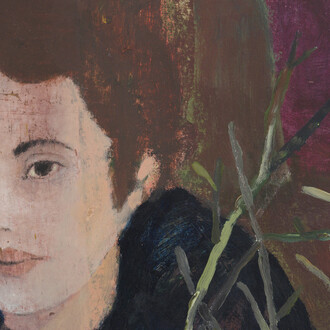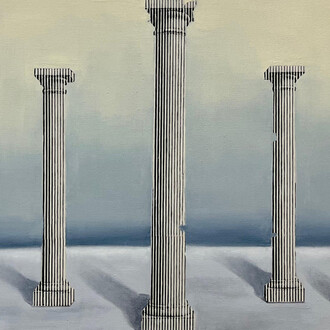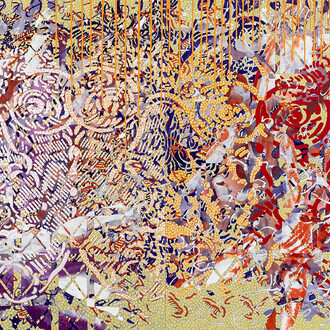Lick a toad and paper-cut your tongue
Lick a toad and feel happy
Lick a toad and the hole in your shoe is a silver Gucci
Lick a toad and get two minutes
Lick thick thread and tremble around the spheres of action.1
Lick the toad gathers artworks, objects, and ephemera, as fragments of vulnerability, dreams, and social alienation. The title takes a line from Lots (2013), a poem by artist and author Tiziana La Melia, which draws on notions of fate and fairy tales, energized by stories such as those of laborers spinning wool all night to keep them awake while working. Similarly, with an anti-capitalist and hallucinatory impetus, the exhibition disrupts dominant narratives of marginalization, value and care. In channeling the fiction of the self and society, toad licking becomes an acid-like gesture, corrosive to the functionality and the homogeneous, stripping away illusions to reveal the raw facets of situated narratives and personal traumas. By interfering with the realms between consensual reality and autofiction, altered states of consciousness and historical facts, the works operate on a mode of understanding that engages with the world through correspondences and metaphors, by a kind of poetry that handles bits and pieces in the dormant forces and realities of life.
Free associations and ramblings permeate the intuitive language of Anne Bourse, shaped by experiences of dissociation and appropriation, assemblages and folds. Grounded in a ghostly vision of learning and creation, a sense of freedom and innocence runs through Charlotte’s skirt pillows (2025), where the vulnerability of objects blends with the self-determination to create. The artist honours the minor art made with thread and textile, presenting Dismorphic golden bench (2024), a hand-woven bench made of golden fabric. The work evokes hypnagogic hallucinations—those fleeting, dreamlike states between wakefulness and sleep—during which the artist, as a child, frequently experienced a distorted sense of body, such as unusually elongated arms and legs. Her hand-crafted books, imperfectly copied, glued, drawn, and printed, fuse paint, pencil, pen, and fragments of ungraspable signs blend with digital impressions, such as in (An epileptic seizure in) Adorables cochons d’Inde, 2018. Colourful writings and spontaneous scribbles are suspended between arabesques and automatisms, asemic writing and communication.
Notions of mental health, subcultures, and fantasy inform Tania Gheerbrant’s installation, whose practice is rooted in historical research. In Alliteration (2025), the artist creates an ephemeral and poetic scenography of posters and verses through silkscreen prints on delicate materials such as fabric, paper, and mirrored foil. Slogans stretch across the posters on the walls, merging with the rhythmic murmur of poems and spoken word from the installation's videos. For the past few years, Tania Gheerbrant has been working with members of the “Réseau des Entendeurs de Voix”, a community, founded in the Netherlands in 1988 and emerged in France in 2011, which offers non-medical spaces for sharing and self-care outside institutional psychiatry, and gives voice to patients as a form of therapy. Inviting viewers to explore documents and witnesses on anti-psychiatric movements, these materials offer a counter-history of madness, unfolding the pervasive mechanisms of alienation within a disciplinary society. She also creates a space for listening to the voices of patients, suggesting how storytelling and imagination can fuel collective resistance beyond the norms of social control.
Tiziana La Melia fools the convention of perception and communication, by addressing how class, identity and immigration shape not just lives, but also bodies and gestures operate within systems of power structured by language. The artist's writing and visual approach conjures memories, experiences, objects, and food towards fables, poems, and personal mythologies, such as in Conditions, 2025. In this piece, the footage from the weather webcam intertwines with a poem that serves as a recipe for mending a broken heart. The spolvero 2 drawing refers to a character in the fable drama series Country mouse city mouse hamster (CMCMH) 3, a roving, episodic project that navigates between rural and urban life, migration and belonging. In the Tabloid series, film stills, behind-the-scenes images, drawings, and research from the CMCMH video are collaged onto canvas and velvet, in moments embellished with pigment, tinted sunscreen and crystals. Here, the triptych format evokes the structure of a tabloid—both in its resemblance to a folded newspaper and in reference to the compact form of medicine tablets, suggesting how storytelling may function as a form of mending. The language of her videos, performances, poems, sculptures, paintings and drawings overcomes any empirical dimension, destabilizes the laws of linear logic, lying in evocative and almost psychedelic semiotic realms.
Notes
1 Tiziana La Melia, “Lots”, in I come from a long line of people who don’t use words, edited by Sonia D’Alto, Archive Books, 2025, p. 34.
2 Spolvero (Italian for "dusting") is a technique, commonly used for fresco, where a design is transferred by punching holes along its outline and dusting pigment through them to create a dotted trace.
3 Video montage of 60 min, digital film shot on DVCAM, 2021/25.
















